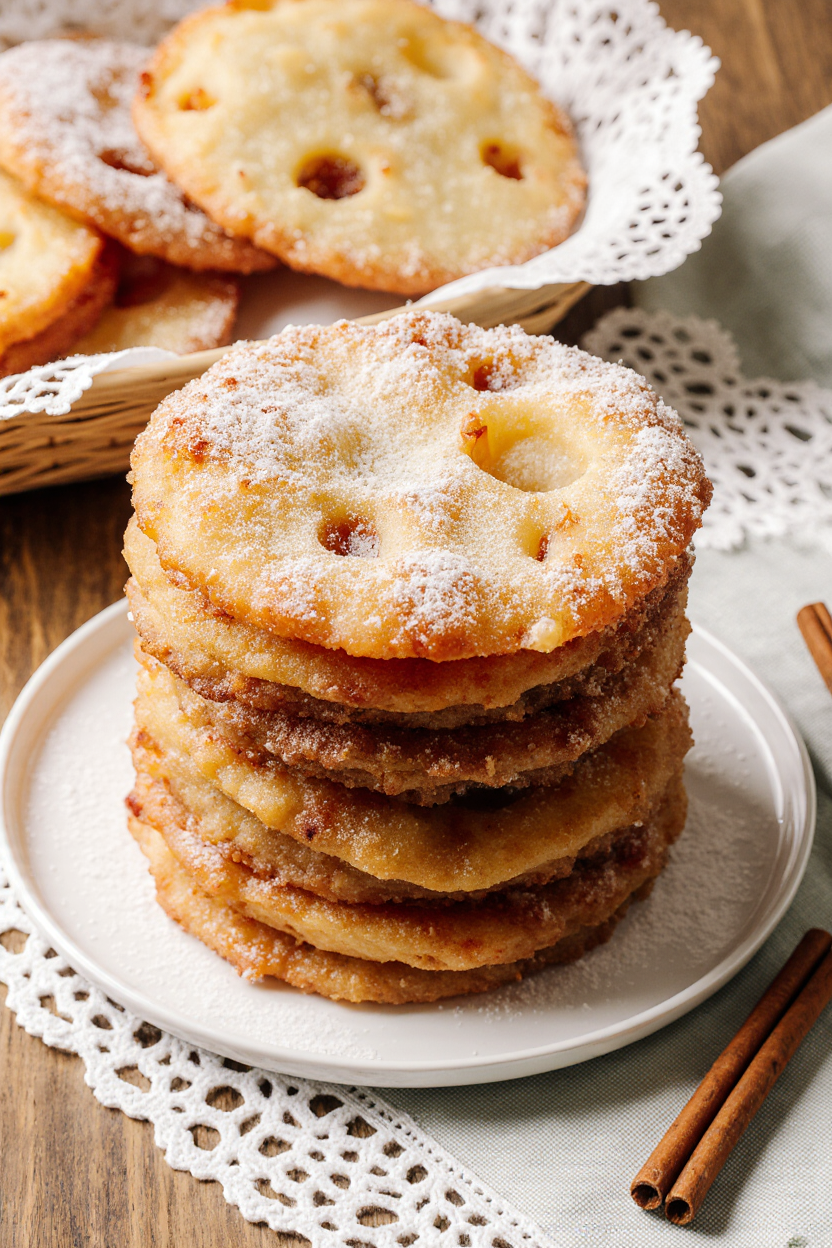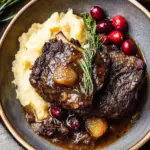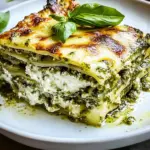The aroma of cinnamon and sugar dances through the air as these traditional Mexican Buñuelos hit the hot oil, crisping to golden perfection. Each bite delivers a light crunch followed by a melt-in-your-mouth sweetness that instantly brings back memories of holidays, family, and warmth.
These beloved treats are a staple during Mexican Christmas festivities, but there’s no need to wait for the holidays. Whether you’re introducing Buñuelos to your family for the first time or recreating cherished traditions, this recipe will make your home smell like a cozy celebration in every season.
Full recipe:
Ingredients:
-
2 cups all-purpose flour (plus ½ cup extra for rolling)
-
¼ teaspoon baking powder
-
¼ teaspoon ground cinnamon
-
¼ teaspoon salt
-
3 tablespoons unsalted butter (room temperature)
-
2 tablespoons sugar
-
1 teaspoon vanilla extract
-
½ cup hot water
-
Canola or vegetable oil, for frying
-
4 tablespoons sugar + 1 teaspoon ground cinnamon (for dusting)
Directions:
-
In a large mixing bowl, combine the flour, baking powder, cinnamon, and salt.
-
Add the butter and work it into the flour mixture using your fingers until it becomes crumbly.
-
Add sugar, vanilla, and hot water. Mix with your hands until a soft, smooth dough forms.
-
Knead the dough on a floured surface for 5-6 minutes. Cover and let it rest for 15 minutes.
-
Divide dough into 14–15 equal portions. Shape each into a smooth ball.
-
Roll each dough ball into a thin circle about 6–7 inches in diameter.
-
Pre-cook each disk for about 10 seconds per side on a hot skillet or comal. Set aside.
-
Heat oil in a deep frying pan to 350ºF (175ºC).
-
Fry each disk individually, pressing the center with a spatula to keep it flat, until golden brown on both sides.
-
Drain on paper towels. While still warm, coat generously with cinnamon sugar.
Prep Time: 40 minutes | Cooking Time: 15 minutes | Total Time: 55 minutes Kcal: 136 kcal | Servings: 15 buñuelos
Cultural and Historical Roots
The origin of Buñuelos can be traced back thousands of years to regions such as Egypt, Turkey, and Morocco, where fried doughs drizzled with honey were common. These traditions made their way to Spain, where they evolved into buñuelos de viento—light, airy puffs often filled with sweet creams or custards. When this culinary tradition crossed the Atlantic during Spanish colonization, it blended with indigenous ingredients and techniques to become uniquely Mexican.
In Mexico, Buñuelos took on a flatter, more tortilla-like shape and were typically served with local sweeteners like piloncillo (unrefined cane sugar) syrup or simply with cinnamon and granulated sugar. Over time, different regions developed their own spins on the recipe. In Oaxaca, they might be dusted with red sugar; in Jalisco, shaped like a bagel; and in Baja California, they’re often soaked in a guava and piloncillo syrup. This regional diversity reflects Mexico’s deep and varied culinary heritage.
What makes Buñuelos particularly special is their presence in seasonal rituals and spiritual traditions. During Las Posadas, a nine-day celebration leading up to Christmas, it’s common to find Buñuelos served alongside tamales and hot drinks. They symbolize joy and abundance—a sweet way to end the year and welcome the new one.
Texture, Flavor, and Presentation
The hallmark of a good Buñuelo is its texture. When prepared properly, the dough becomes paper-thin, light, and airy during frying. This creates an irresistible crunch that contrasts beautifully with the soft granules of sugar coating its surface. They should shatter slightly when bitten, providing that perfect crunch that melts into sugary, cinnamony warmth.
Flavor-wise, Buñuelos are deceptively simple. Their base is unsweetened dough, but the addition of butter, cinnamon, and vanilla gives the final product a warm, nostalgic taste. The sugar coating or piloncillo syrup adds an extra layer of sweetness that makes them shine as a dessert or festive snack.
Presentation is also an essential part of the experience. Often served warm, Buñuelos can be arranged in a stack like pancakes, lightly overlapped on a platter, or even wrapped in colorful cellophane for gifting during the holidays. They’re visually striking thanks to their golden hue and fine sugar dusting, making them irresistible at any gathering.
Tips for Perfect Buñuelos
While the ingredients are straightforward, achieving the ideal texture and appearance takes some practice and a few helpful techniques. One pro tip is to pre-cook the dough discs briefly on a hot skillet before frying. This step firms up the dough slightly, making them easier to handle and reducing the chances of tearing during frying.
Maintaining oil temperature is also crucial. The oil should be hot—about 350°F (175°C)—to ensure the dough crisps quickly without absorbing too much oil. Frying one Buñuelo at a time allows you to manage the temperature and appearance better, preventing burning or uneven cooking.
Another helpful trick is using a spatula to press down the center of the dough during frying. This ensures the Buñuelo stays flat and evenly cooks across the surface. Once fried, it’s important to coat them in sugar while still warm so that the mixture adheres properly.
Modern Takes and Creative Serving Ideas
Although traditionally served plain with cinnamon sugar or syrup, Buñuelos have inspired countless modern variations. Some cooks now serve them with sweetened condensed milk, a trend growing in popularity across Mexico. Others drizzle melted chocolate, cajeta (goat’s milk caramel), or Nutella over the warm crisps for a fusion-style dessert.
In the culinary world, chefs have also begun to use Buñuelos as a base for more elaborate creations. For example, layering them with whipped cream and fruit compote can create a dessert similar to a mille-feuille. Some even break them into shards and use them as crunchy garnishes on ice cream or pudding.
The versatility of Buñuelos allows for both adherence to tradition and innovative reinterpretations, making them a timeless addition to any dessert repertoire.
Storing and Reheating
Buñuelos are best enjoyed fresh and warm, but they can be stored for a few days without losing too much of their signature crunch. After they’ve cooled completely, they should be wrapped gently in plastic wrap or stored in airtight containers. This helps preserve their crispness and protects them from humidity, which can make them soggy.
For reheating, a quick 10 to 15 seconds in the microwave is usually enough to warm them without compromising texture. It’s important not to overheat them, or they may become chewy. Alternatively, a brief stint in a preheated oven can also help revive their crispiness.
Buñuelos in Family and Festive Traditions
Beyond their flavor, Buñuelos hold emotional and cultural weight in Mexican households. For many, making Buñuelos is a family activity, often passed down from grandparents to children. It’s a way of connecting with heritage, revisiting memories of holidays past, and preserving culinary traditions for the next generation.
During the holidays, their aroma fills the kitchen, mingling with the scent of tamales, ponche navideño (Christmas punch), and other festive dishes. Buñuelos are often the final touch to a meal, shared over stories, laughter, and warm drinks. They’re a moment of indulgence and togetherness—a shared celebration in every bite.
Even for those who live outside of Mexico, Buñuelos serve as a connection to home. Making them from scratch can evoke a powerful sense of nostalgia and belonging, whether you’re in California, Canada, or anywhere else in the world.
Conclusion
Mexican Buñuelos are more than just fried dough—they’re a symbol of tradition, heritage, and shared joy. Their crisp texture, warm flavors, and cultural significance make them a standout dessert in any festive gathering. Easy to love and even easier to eat, Buñuelos continue to unite generations around the table.
Whether you’re rediscovering a family recipe or making them for the first time, Buñuelos offer a beautiful way to celebrate the season. They embody the warmth, generosity, and creativity at the heart of Mexican cuisine, proving that the simplest ingredients often yield the most meaningful moments.






